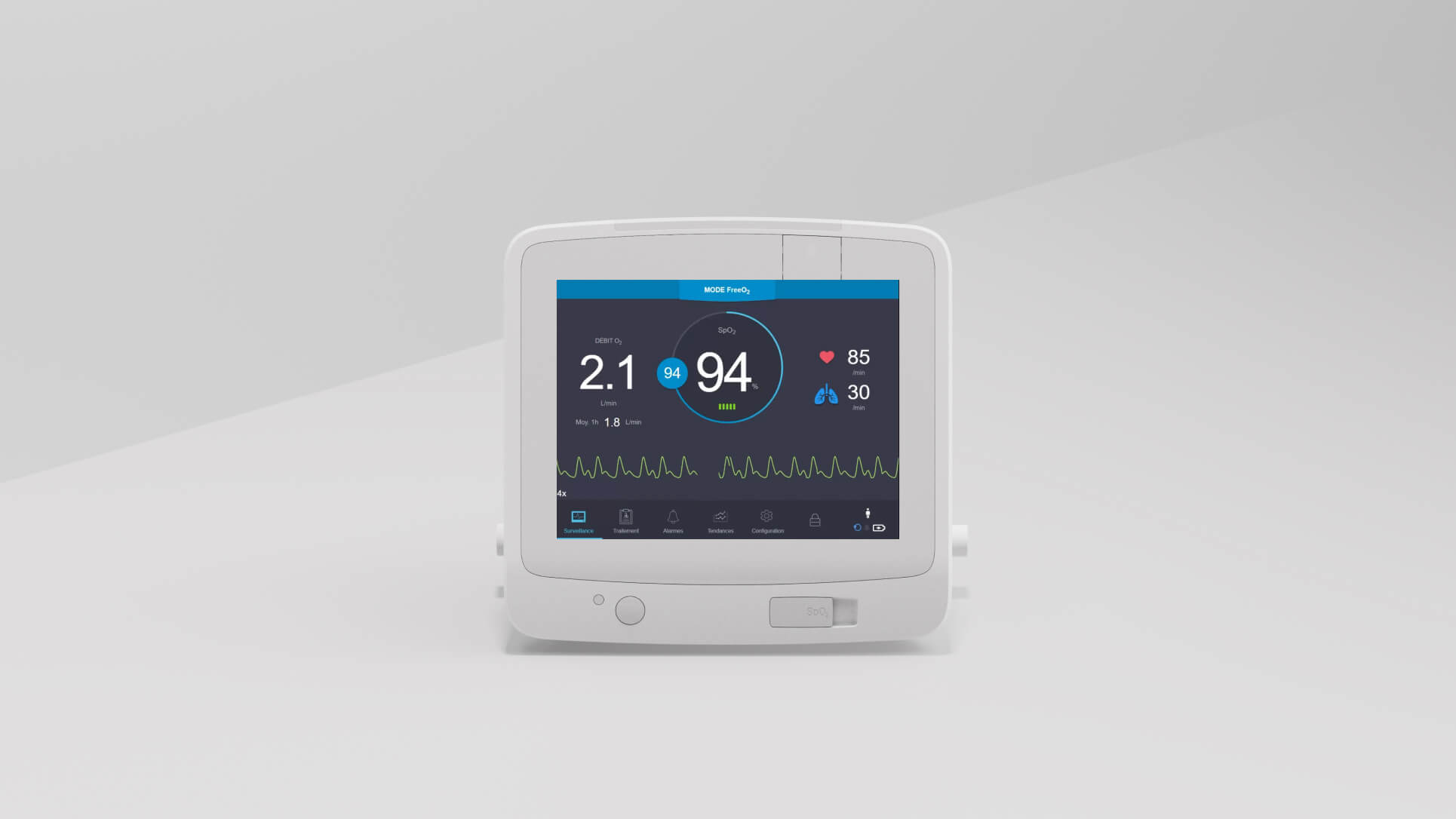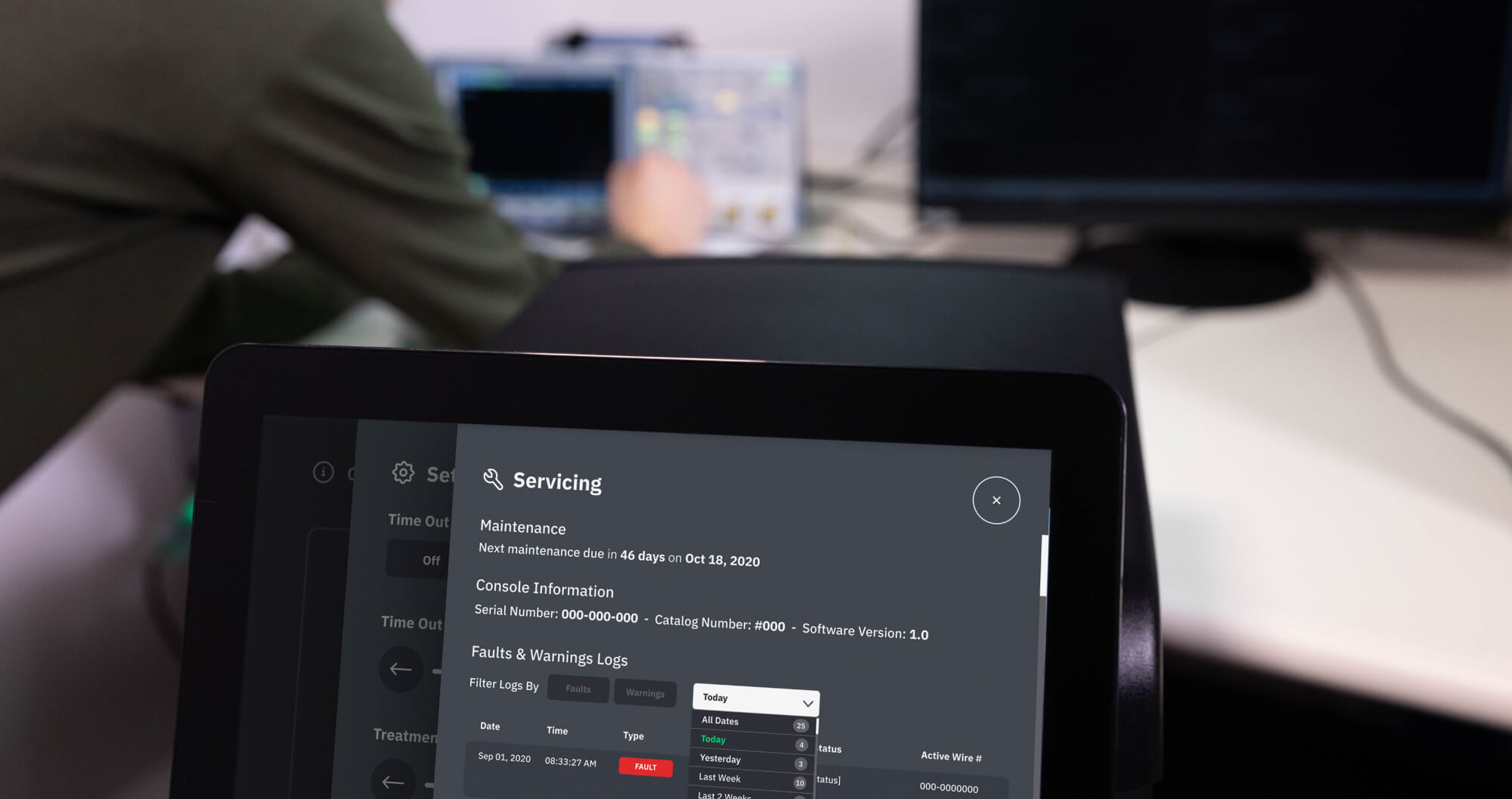However, this technology is not without risks, particularly in the event of a failure. In an industry where patient safety is non-negotiable, it is essential to mitigate any potential hazards that could arise from such incidents.
Guided by Marc-André Filion, electronic engineer at CLEIO, let’s dive into the risks associated with touchscreen failures and explore solutions to ensure their reliability and safety.
Touchscreens: A Solution with Many Benefits for Medical Devices
Touchscreens are an ideal solution for medical devices, offering intuitive support to operators—whether clinical staff or patients—when using the device. Interfaces designed by experts in human factors and user experience are not only visually appealing but also highly user-friendly.
The Risk of Failure: A Major Challenge in the Medical Sector
To better understand the challenges associated with touchscreen failures in the medical field, it’s helpful to compare them to those in the aerospace sector.
Touchscreens present similar challenges in both domains, especially when used in critical applications. In the event of a failure, the touchscreen ceases to function, often without a backup solution. This is unacceptable for primary flight instruments in aviation, and the same holds true for medical devices, where failures can directly affect patients’ lives or cause permanent injuries.
In airplanes, this risk is mitigated by redundancy: two identical systems operate simultaneously, ensuring the flight can continue if one system fails. Unfortunately, in the medical field, it’s not feasible to use two devices at the same time during a procedure. This makes it essential to anticipate potential technical failures and implement alternative solutions to maintain safety and functionality.

What Are the Failure Modes of a Touchscreen?
Before exploring failure modes, it’s important to understand the composition of a touchscreen. A touchscreen is made up of two main components: the screen, which displays images, and the touch interface, which enables interaction with users through touch.
1
Screen Failures
The failure modes of the screen vary depending on the underlying technology, such as LCD or OLED. For instance, an LCD screen consists of two primary parts: the backlight and the LCD panel itself. Each component is susceptible to distinct types of failures:
LCD Failure
An LCD consists of pixels arranged in rows and columns. Each pixel combines three colors—red, green, blue—and is controlled by a dedicated circuit that adjusts the intensity of these colors. A conversion circuit acts as a bridge between the processor and the screen, managing the rows and columns to display the intended image.
Although each row lights up individually, the rapid refresh rate of the screen creates the perception of a continuous image.
However, various types of failures can occur in an LCD, potentially affecting its performance:
Power Circuit Failure in a Row
Causes: Mechanical impact, circuit aging, manufacturing defects, or thermal shock.
Effects: Affected rows stop functioning, appearing as thin black lines on the screen. If multiple rows are impacted, larger black bands may form.
Pixel Control Circuit Failure (Columns)
Causes: Mechanical impact, circuit aging, manufacturing defects, or thermal shock.
Effects: One or more colors in a column fail to display, causing incorrect colors or leaving the column black. Multiple failures can lead to defective vertical bands.
Main Conversion Circuit Failure
Causes: Mechanical impact, aging of the interconnection cable, or electrostatic discharges.
Effects: Complete loss of the image or total loss of one or more colors, preventing proper image display.
Backlight Failure
The backlight of a touchscreen is essential for displaying images clearly. It is typically powered by LED diodes (either white or RGB) positioned behind the LCD panel.
These diodes are arranged to provide uniform brightness across the screen surface, aided by various optical filters.
Loss of Light
LED Failure
Reduced Brightness Intensity
2
Touch Interface Failures
The failure modes of the touch interface depend largely on the chosen technology, but their effects are typically similar.
Control Interface Failure
Causes: Electrostatic discharge, signal integrity issues, mechanical impact.
Effects: Complete loss of touchscreen functionality.
Detection Failure
Identifying the Risks of Touchscreen Failures
While the risk of failure exists, it is possible to design a touchscreen that is compatible with any type of medical equipment. Achieving this requires a comprehensive risk analysis.
This process helps pinpoint weaknesses in the device’s design and enables the implementation of measures to prevent critical malfunctions.
Risk Analysis
A detailed understanding of the potential failures of a touchscreen is key to evaluating their impact on the product. Collaboration with a human factors team can help identify failure points that may affect workflow or usability.
Testing
Signal Integrity Testing
Software Testing and Calibration
Pre-Certification Testing
Mechanical and Environmental Testing
Regulatory Standards
While there is no specific standard dedicated to touchscreens, these electronic subsystems must comply with the foundational standards for electronic medical devices, particularly IEC 60601 and its variants. Special attention should be paid to IEC 60601-1-2 (addressing electromagnetic compatibility) and IEC 60601-1-11 (for devices intended for home use).

Incorporating Measures to Mitigate the Risks of Failure
While failures associated with touchscreens can have serious consequences, particularly when they disrupt the operation of a medical device that directly impacts patient health, the use of touchscreens should not be prohibited. Numerous strategies exist to mitigate these potential risks.
Enabling Cleaning and Disinfection
The materials used in touch interface construction can be sensitive to cleaning and disinfecting agents. To ensure durability and compatibility, it is important to select appropriate materials. For instance, glass is often preferred over polyester films due to its superior resistance. Additionally, the quality of glass coatings should be carefully considered.
Adding a Monitoring Circuit
Incorporating a monitoring circuit ensures that the touch interface remains operational. This circuit works in tandem with a fault-response process, helping to mitigate risks to the patient by stopping ongoing procedures and providing visual and auditory alerts in case of malfunction. Activity can be verified by analyzing video signals or monitoring the screen’s energy consumption.
Incorporating Mechanical Buttons
The presence of a touchscreen interface does not necessitate the complete elimination of mechanical buttons. On the contrary, these buttons can enhance safety by serving as an additional layer of protection.
Mechanical buttons can also be integrated around the screen to create a hybrid interface. In this setup, critical actions can be performed using mechanical buttons, while tasks like device configuration and information display can be handled through the touchscreen interface.
Add a Second Touch Detection Method
Combining two touch detection methods, such as a capacitive touchscreen and an infrared touchscreen, is entirely feasible. This approach enables confirmation of a touch from two independent sources, ensuring its legitimacy.